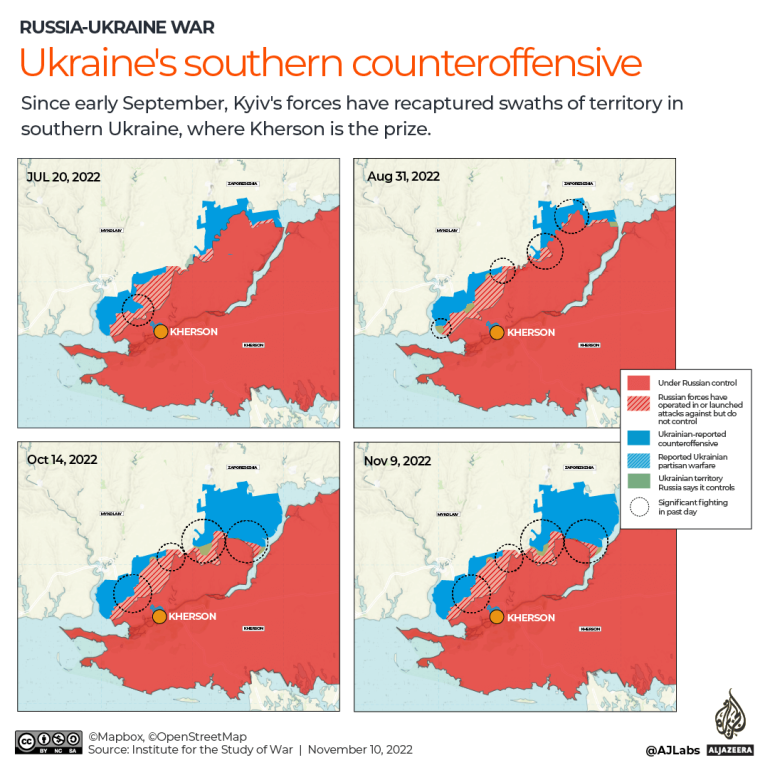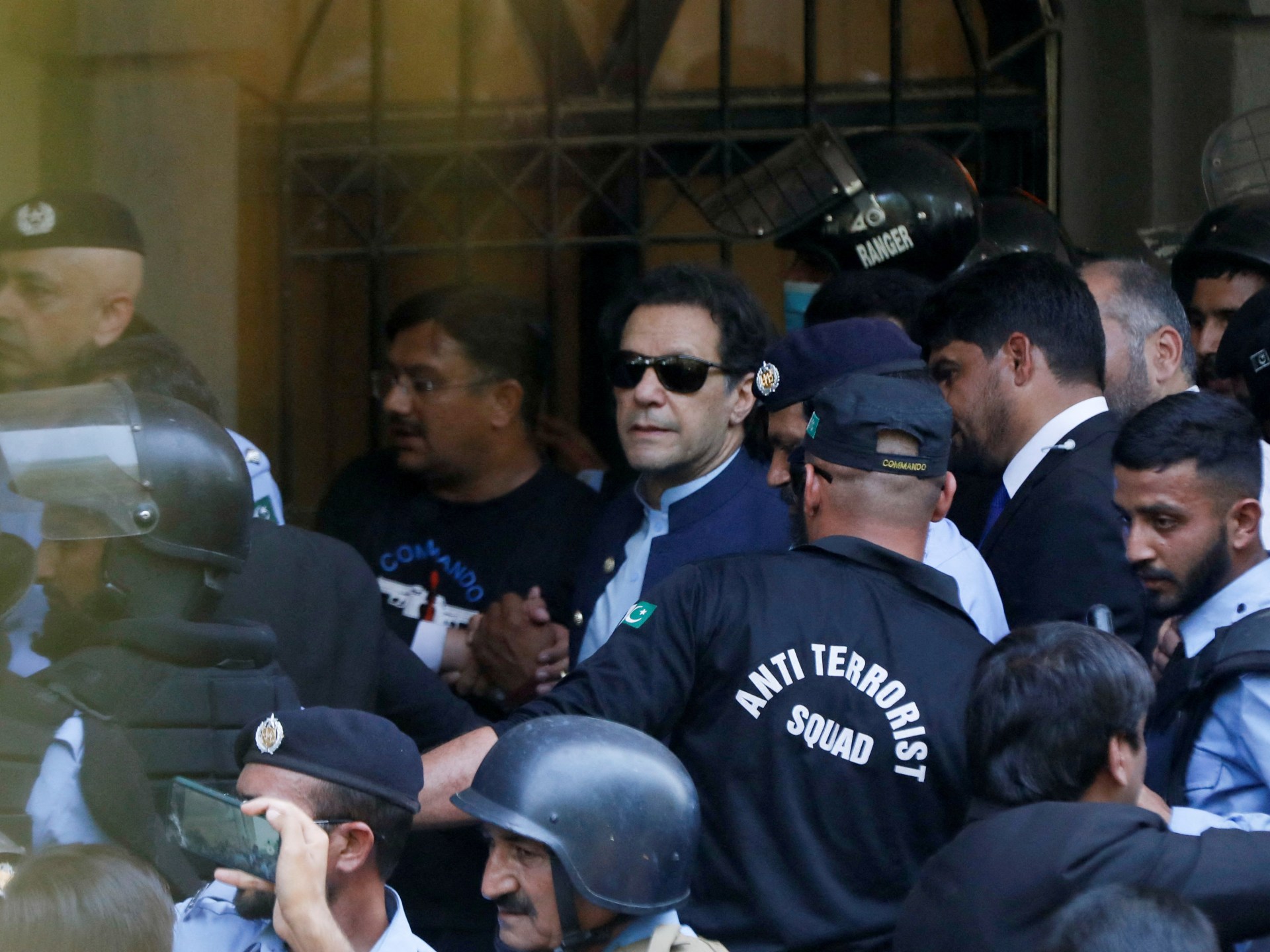How will Russia’s withdrawal from Kherson unfold?
Russia says it has begun withdrawing troops from the city of Kherson in southern Ukraine, signalling a major retreat from the only regional capital its forces had captured since the beginning of the war.
Units were “manoeuvring to [a] prepared position” on the eastern bank of the Dnieper River on Thursday, Russia’s defence ministry said, in “strict accordance” with the plan to pull back announced a day earlier.
Meanwhile, Ukraine’s own forces were advancing in the wider southern Kherson region, reportedly retaking a swath of settlements and pressing towards Kherson city itself.
But Kyiv has voiced concern that Russia’s announced withdrawal may be a ruse designed to lure Ukrainian soldiers into potentially brutal urban fighting for control of the strategically important industrial port city, which had a pre-war population of nearly 300,000 people.
So, here is what you need to know about Russia’s announced retreat.

How many Russian troops are in Kherson?
It is not clear exactly how many Russian soldiers are currently in Kherson – which lies in one of four regions which President Vladimir Putin proclaimed annexed a month ago – nor how many were stationed there prior to Moscow announcing its withdrawal from the regional capital.
General Mark Milley, the top military official in the United States, Ukraine’s foremost Western ally, said on Wednesday that Russia may have amassed between 20,000 to 30,000 troops in the city.
Why are they withdrawing and where are they pulling back to?
Moscow’s announced plan is focused on pulling its forces back across the Dnieper River, owing to the difficulty of maintaining supply lines to its troops in Kherson.
Satellite imagery and reports from the region indicate the Russians have, in recent weeks, been carving out several lines of defensive trenches on the waterway’s eastern bank in anticipation of the move.

When will the withdrawal unfold?
Moscow has provided no information concerning the pace of its withdrawal, while Kyiv has dismissed reports of a pullback for the time being.
Ukrainian officials have warned for weeks that any announcement of a Russian retreat should be treated sceptically. They have accused Moscow of plotting to lure Ukrainian troops into an ambush and said Russian soldiers have donned civilian clothes in an effort to melt into Kherson’s population.
“Until the Ukrainian flag hovers over Kherson, it makes no sense to talk about the withdrawal of Russian troops,” Mykhailo Podolyak, an aide to Ukrainian President Volodymyr Zelenskyy, said on Wednesday.
But Milley, the chairman of the US Joint Chiefs of Staff, said that “initial indicators” suggested Russian forces were in fact withdrawing.
The Institute for the Study of War (ISW), a think-tank that tracks the conflict, also said recent movements by Moscow’s forces indicated the pullback was taking place.
“The Russian withdrawal from the west bank of the [Dnieper] is unlikely to be a trap meant to lure Ukrainian troops into costly combat near Kherson city, as some Ukrainian and Western sources have suggested,” ISW wrote in an update on Thursday.
“ISW has previously observed many indicators that Russian forces, military and economic assets, and occupation elements have steadily withdrawn,” the think-tank added.
Regarding the pace of the withdrawal, Milley said a full retreat could take several weeks.
His view was echoed by Ukrainian military analyst Oleh Zhdanov, who suggested a quick transfer of Russian troops from one side of the river to the other was an impossibility given the Ukrainian army has been systematically destroying bridges and roads in the area in recent months.

Will retreating troops be vulnerable to attack?
Carrying out a tactical withdrawal of forces from any active battlefield is a notoriously complex task, one typically laden with danger for the withdrawing troops.
The United Kingdom, another major ally of Ukraine’s, said on Thursday that Russian units will be particularly “vulnerable” to attacks as they retreat given there are “limited crossing points” along the Dnieper River.
“It is likely that the withdrawal will take place over several days with defensive positions and artillery fires covering withdrawing forces,” the UK’s Ministry of Defence said in its latest daily intelligence update.
Zhdanov, the Ukrainian military analyst, echoed the ministry’s assessment of the risks faced by Moscow’s forces as they pull back.
“The main question is whether the Ukrainians will give the Russians the opportunity to calmly withdraw, or fire at them during the crossing to the left bank,” Zhdanov was quoted as saying by The Associated Press news agency.
“The personnel can be taken out on boats, but the equipment needs to be taken out only on barges and pontoons, and this is very easily shelled by the Ukrainian army,” he added.

What will happen next?
It is anticipated that Ukrainian forces will press towards Kherson in the coming days.
Meanwhile, Ukrainian officials have warned Russia may launch sustained artillery attacks on the regional capital from their fortified positions on the east bank of the Dnieper River, saying Moscow intends to turn it into a “city of death”.
RF wants to turn Kherson into a “city of death”. Ru-military mines everything they can: apartments, sewers. Artillery on the left bank plans to turn the city into ruins. This is what “Russian world” looks like: came, robbed, celebrated, killed “witnesses”, left ruins and left.
— Михайло Подоляк (@Podolyak_M) November 10, 2022
Analysts have suggested that even if Ukraine is successful in retaking the city, it is unlikely its forces will attempt to press further east in the immediate future.
“It is unlikely the Ukrainians will be undertaking a large-scale crossing of the Dniepr to the eastern bank anytime soon,” Mick Ryan, a retired Australian general, said on Thursday.
“Not only would this be a massive, deliberate operation, it would attack into a dense series of Russian defensive zones,” he said. “Consequently, the Ukrainians – who prefer to attack indirectly … and corrode the Russians from within – will look for other opportunities in other areas to clear the Russians from the south.”
5/ What about Ukraine’s next steps? It is unlikely the Ukrainians will be undertaking a large scale crossing of the Dniepr to the eastern bank anytime soon.
— Mick Ryan, AM (@WarintheFuture) November 10, 2022
Is this a turning point in the war?
For Kyiv, recapturing Kherson would strengthen its belief that it can defeat Russia on the battlefield.
For Russia, its loss would signal the most significant retreat since Moscow’s forces were driven back from the outskirts of Kyiv in March and a clear shift in the momentum of the nine-month-old war.
However, Moscow’s forces do still control vast tracts of land in southeastern Ukraine – including a vital land route connecting Russia to the Crimea Peninsula it seized in 2014 – and in the eastern regions of Donetsk and Luhansk.
With the imminent onset of bitter winter conditions that could freeze existing front lines in place, Russia may now be looking to bide its time before launching new offensives in the spring, bolstered by more than 300,000 reservists called up during a recent partial mobilisation drive.




